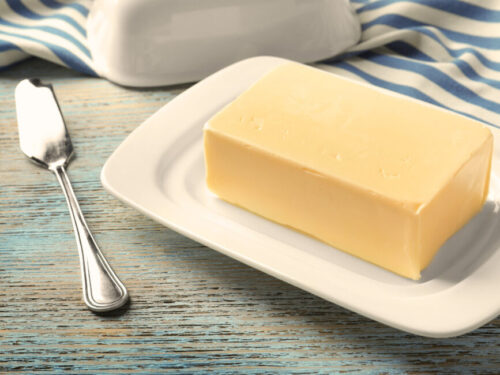You’re in your kitchen, about to whip up some mouth-watering toast or maybe some pancakes. You reach for that all-important ingredient – butter. But then you pause, butter in hand, facing the age-old kitchen conundrum: “Should this golden goodness be living in the fridge or chilling out (pun intended!) on the countertop?”
It’s a question that’s sparked many a breakfast table debate. To refrigerate or not to refrigerate – that is the question. And let’s be honest, it’s not just about butter; it’s about enjoying that perfect, easily spreadable slice of toast without tearing the bread to shreds.
In this blog post, we’re diving deep into the world of butter storage. We’ll explore all sides of this buttery debate, from the food safety smarts to the quest for the perfect spreadable consistency. Whether you’re Team Fridge or Team Counter, I promise you’ll find some food for thought here. So, let’s get ready to spread some knowledge (and butter) as we unravel the mystery of butter storage together!

Understanding Butter
Before we jump into the fridge vs. counter debate, let’s take a moment to understand our creamy companion a bit better. After all, knowing what butter is and its different types will help us make sense of how to store it.
What is Butter, Exactly?
- Butter Basics: At its core, butter is pretty simple. It’s made primarily from the fat and protein components of milk or cream. Typically, butter is churned from cream, separating the butterfat from the buttermilk.
- A Rich History: The art of butter-making dates back thousands of years. Ancient civilizations realized that by agitating cream, they could transform it into this deliciously spreadable fat. Fast forward to today, and butter is a staple in cuisines worldwide.
Types of Butter
- Salted vs. Unsalted Butter: The most basic division in the world of butter. Salted butter, as the name suggests, has salt added to it, which acts as a natural preservative. Unsalted butter, often labeled as “sweet cream butter,” has no added salt.
- Grass-Fed Butter: Comes from cows that have been fed primarily on grass. Many swear it’s creamier and richer in flavor, and it’s often touted for having a slightly higher nutrient content.
- Cultured Butter: This type is made from cream that’s been fermented before churning. It has a tangier taste compared to regular butter.
Properties Influencing Storage
- Fat Content: Butter has a high fat content, which influences how it reacts to temperature. At room temperature, it softens, which makes it easily spreadable. In the fridge, it hardens, which is great for certain types of baking but not so much for spreading on your morning toast.
- Moisture Level: Butter also contains a bit of water. When left out, the water content can make butter more prone to going rancid, especially in warmer conditions.
- The Salt Factor: Salted butter has a longer shelf life at room temperature compared to unsalted butter, thanks to the preservative effect of salt.
Understanding these basics of butter, from its types to its properties, sets the stage for our next sections, where we’ll delve into the reasons for and against refrigerating this culinary delight.

Reasons to Refrigerate Butter
Now, let’s butter up the facts about why many of us keep our butter in the fridge. There are some pretty good reasons for this chilly habit, and they go beyond just following what we’ve always done.
Extending Shelf Life
- Slowing Down Spoilage: The primary benefit of refrigerating butter is extending its shelf life. Butter contains milk fats that can go rancid over time, especially when exposed to heat and light. Refrigeration slows down this process, keeping your butter fresher for longer.
- How Long Does it Last? In the fridge, butter can remain good for several weeks, even months. This is a significant extension compared to room temperature storage.
Maintaining Texture and Flavor
- Consistent Quality: Refrigeration keeps butter at a consistent texture. For baking enthusiasts, this is crucial. Cold butter is needed for pastries and pie crusts to achieve that perfect flakiness.
- Flavor Preservation: Keeping butter cold also helps maintain its flavor profile. Warm temperatures can cause subtle changes in flavor over time, especially in unsalted or cultured varieties.
Food Safety Considerations
- Bacteria Growth: Like many dairy products, butter can become a breeding ground for bacteria if not stored properly. While the risk is lower compared to other dairy products (thanks to its high-fat content), it’s still a consideration.
- The Warmer, the Riskier: In warmer climates or during hot summer months, the risk of butter going bad increases if it’s left out. Refrigeration is especially important in these conditions to prevent any foodborne illnesses.
Different Needs for Different Types of Butter
- Salted Butter: The salt in salted butter acts as a preservative, which means it can last a bit longer at room temperature than unsalted butter. However, to maximize its shelf life and maintain quality, refrigeration is still recommended.
- Unsalted Butter: With no salt to protect it, unsalted butter is more vulnerable to going rancid. Refrigeration is particularly important for this type of butter to keep it fresh and safe to eat.
- Specialty Butters: For butters like grass-fed or cultured, which may have different fat and moisture content, following the manufacturer’s storage recommendations is key. Usually, this will involve refrigeration to preserve their unique flavors and textures.
In short, refrigerating butter is about playing it safe and ensuring you get the best out of your butter, both in terms of shelf life and quality.

The Case for Room Temperature Butter
While the fridge has its perks for butter storage, there’s a compelling case for keeping butter at room temperature too. Let’s spread out the reasons why some folks prefer their butter a bit more… relaxed.
The Joy of Spreadability
- Easy to Spread: The most obvious reason for keeping butter out of the fridge is spreadability. There’s nothing quite as satisfying as butter that glides smoothly over toast, bagels, or fresh bread without tearing it apart.
- Immediate Use: Room temperature butter is a boon for those spontaneous baking moments or when you need a quick swipe of butter for cooking.
Enhanced Flavor
- Full Flavor Profile: Some butter enthusiasts argue that butter at room temperature has a fuller, more robust flavor. This can be particularly noticeable in high-quality or artisan butters, where you really want to taste the nuance.
- Taste Test: Try tasting cold butter and then room temperature butter of the same type side by side. Many find the latter to have a more pronounced flavor.
Safe Practices for Room Temperature Butter
- Limited Quantity: As per the USDA’s recommendation, it’s wise to only leave out the amount of butter you’ll use within two days. This helps to avoid the butter turning rancid. Because salt works as a natural preservative, salted butter last longer than unsalted outside of the fridge.
- Butter Dishes: To keep butter safe and clean at room temperature, use a butter dish with a cover. This keeps out contaminants and helps maintain a consistent texture.
- Location Matters: Store your room temperature butter in a cool, dark place away from direct sunlight or heat sources. A kitchen cupboard or a shaded part of the countertop works well.
- Margarine Considerations: Margarine can also be stored at room temperature under similar conditions. However, it’s important to read the label for any specific storage recommendations, as formulations can vary.
Balancing Taste and Safety
- A Little at a Time: By keeping just a small amount of butter out and the rest in the fridge, you can enjoy the benefits of spreadability without worrying about waste or safety. This way, you have fresh, spreadable butter when you need it, and the bulk of your supply stays fresh and safe in the fridge.
In conclusion, keeping butter at room temperature is all about convenience and taste. By following safe practices and being mindful of how much you leave out, you can enjoy perfectly spreadable butter without any drawbacks.

Other Butter-Related Questions
In our buttery exploration, we’ve spread across a range of topics. But there’s more to churn through! Here are some additional butter-related questions, complete with factual answers to keep you well-informed and your butter at its best.
What Are Some Ways I Can Store Butter?
- In the Fridge: The standard way to store butter in the fridge is to keep it in its original packaging or a resealable container. This protects it from absorbing flavors and odors from other foods.
- Butter Bell or Crock: For room temperature storage, a butter bell or crock is a great option. It uses water to create a seal that keeps butter fresh while keeping it spreadable. Note that this option is only for real butter and not margarine.
- Butter Dish: A classic butter dish with a lid is perfect for short-term room temperature storage. Just ensure it’s placed away from heat sources or direct sunlight.
How Can I Tell if Butter Has Gone Bad?
- Sight and Smell: The first indicators are visible mold and an off smell. Rancid butter will have a sour, unpleasant odor and possibly a change in color.
- Bad Taste: Rancid butter has a noticeably sour and unpleasant flavor.
- Texture Changes: Look for any significant changes in texture. While some oil separation is normal, extreme separation or a gritty texture is a sign that the butter is past its prime.
What is the Best Way to Soften Butter Quickly?
- Cut Into Small Pieces: To soften butter quickly, cut it into small chunks. More surface area means it will soften faster at room temperature.
- Use a Warm Glass: Warm a glass with hot water, dry it, and then cover the butter with it. The residual heat will soften the butter without melting it.
Freezing Butter: Is it an Option?
- Butter in the Freezer: Yes, you can freeze butter! It’s a great way to extend its shelf life for months. Just make sure it’s well wrapped or in an airtight container to prevent freezer burn and flavor absorption.
- Thawing Butter: When you need it, simply transfer the butter from the freezer to the fridge to thaw slowly, or leave it out at room temperature for quicker use.
What are Some Butter Substitutes for Cooking and Baking?
- Alternatives for Cooking: For cooking, olive oil, coconut oil, or other cooking oils can substitute for butter in many recipes.
- Baking Substitutes: In baking, applesauce, mashed bananas, or yogurt can be used as alternatives, keeping in mind they may slightly alter the flavor and texture of the final product.
With these buttery insights, you’re now well-equipped to handle all things butter, from storage to spoilage signs.

Spreading the Final Word on Butter Storage
Ultimately, it all boils down to preference and lifestyle. Whether you’re a fan of rock-hard butter straight from the fridge or you prefer it soft and spreadable at room temperature, the choice is yours. But, if you do opt for keeping your butter out, let’s remember the golden rule from the USDA: only leave out the amount of butter you’ll use within two days. This is particularly wise advice for unsalted butter, which doesn’t have the added protection of salt.
Speaking of salted butter, it’s your best bet for room temperature storage. Its added salt acts as a natural preservative, making it a little more forgiving if left out for a couple of days.
Now, I’d love to hear from you! How do you store your butter? Are you a fridge fanatic or a countertop connoisseur? Maybe you’ve got some buttery wisdom to share or a killer recipe that transforms ordinary dishes into extraordinary culinary experiences. Drop your thoughts, practices, and recipes in the comments below. Let’s keep the conversation as smooth and spreadable as our favorite butter!
Here are Some of Our Favorite Buttery Recipes
- Easy Flavored Butter Recipes
- Steak with Kimchi Butter
- Miso Butter Shrimp Recipe
- Grilled Corn with Lime Cilantro Wasabi Butter
The post Should Butter Be Refrigerated? appeared first on Steamy Kitchen Recipes Giveaways.
from Steamy Kitchen Recipes Giveaways https://ift.tt/RJCfP0V
via New Kitchen Special
No comments:
Post a Comment